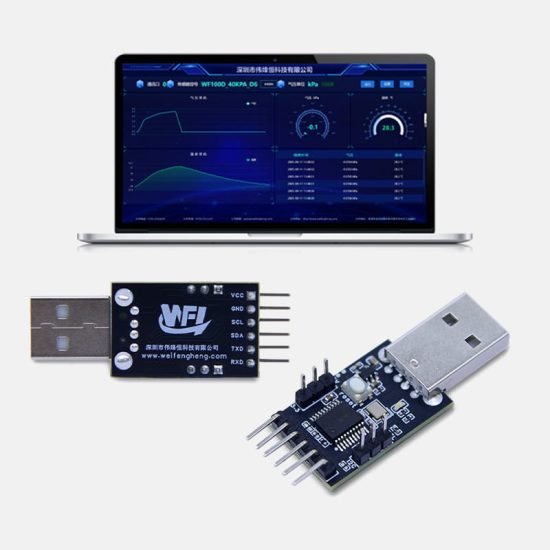ລາຍການ
Wearable devices, smartphones, drones, weather stations, automotive electronics, and industrial automation are increasingly demanding high-precision, low-power barometric data. Digital pressure sensors stand out with their high integration, user-friendly digital interfaces, compact size, and software-configurable parameters. This article explores integration solutions for digital pressure sensors—covering digital output, interface compatibility, signal conditioning, temperature compensation, and mass-production testing—to achieve reliable ±0.1 hPa accuracy while simplifying system design and reducing development costs.
1. Application Scenarios and Requirements
1.1 Industry Background
The proliferation of IoT and intelligent devices has made real‐time barometric monitoring essential for altitude measurement, weather alerts, flight‐control height, and indoor navigation. Engineers and technical decision‐makers prioritize achieving ±0.1 hPa accuracy within tight space and power budgets. Procurement managers seek sensors with standard I²C/SPI interfaces for plug‐and‐play integration without extra analog front‐ends or complex calibration circuits.
1.2 Key Performance Metrics
Critical focus areas include digital output precision and noise immunity, embedded signal conditioning and temperature compensation, I²C/SPI bus compatibility, and miniaturization with low‐power operation. An ideal digital pressure sensor integrates amplifier, ADC, calibration logic, and compensation in one package, providing software‐configurable digital interfaces and guaranteeing stable ±0.1 hPa accuracy with microamp‐level current draw.
2. Device Architecture and Integration Solutions
2.1 MEMS Element and ASIC Integration
A typical digital pressure sensor combines a MEMS silicon diaphragm (piezoresistive or capacitive), analog front‐end amplifier, high‐resolution Σ-Δ or SAR ADC, and on‐chip temperature compensation logic. The MEMS diaphragm’s microvolt‐level signal is amplified, digitized by the ADC, then corrected using factory‐stored calibration coefficients in EEPROM or OTP before delivering high‐precision readings via I²C/SPI bus
2.2 Digital Communication Interfaces
Most sensors support I²C standard (100 kHz/400 kHz) and Fast‐mode Plus (1 MHz), or SPI 3/4‐wire modes. I²C devices typically use a fixed slave address (e.g., 0x28), enabling multi‐byte readings of pressure and temperature, plus FIFO buffering to reduce host interrupts
2.3 PCB Layout and Packaging
To maintain mechanical integrity and pressure access, packages feature top vents or flexible membranes. PCB designs must leave an opening beneath the sensor for ambient connection, follow split ground planes, differential‐pair routing, and decoupling best practices, and avoid proximity to heat or vibration sources to ensure ±0.1 hPa stability

3. Software Configuration and Calibration
3.1 Factory Calibration
Top‐tier digital sensors undergo multi‐point pressure and full‐range temperature calibration at the factory, storing coefficients on‐chip for immediate use, shortening system bring‐up time, and boosting data reliability
3.2 Driver and Register Map
Firmware interfaces read WHO_AM_I and control registers to set output data rate, digital filter, and FIFO thresholds. Common registers include PRESS_OUT_L/H, TEMP_OUT_L/H, CONFIG, and INTERRUPT sources.
3.3 Onboard Filtering and Compensation
MCU‐side algorithms (e.g., Kalman filter, moving average) can further suppress noise, while dynamic temperature compensation based on live readings corrects zero drift and scale factor shifts, preserving long‐term accuracy.
4. Performance Advantages and Adaptability
4.1 High Integration and Reliability
Compared to analog sensors plus external ADCs, digital sensors’ internal integration of amplification, ADC, compensation, and calibration reduces component count and EMI paths, improving consistency and reliability
4.2 Compatibility and Cost Efficiency
Standardized I²C/SPI interfaces allow direct MCU/SoC connection without extra analog front‐ends, lowering PCB area and BOM costs. Software‐configurability reduces hardware revision cycles, accelerating time to market.
4.3 Environmental Robustness
Advanced sleep/wake modes yield standby currents <1 µA, ideal for battery‐powered systems. Packages rated up to IP67 and –40 °C to +85 °C operation, with anti‐condensation design, suit outdoor weather stations, drone flight, and automotive electronics.
5. Pre-Production Testing and Validation
5.1 Test Metrics and Methods
Key metrics include zero offset, full-scale output, temperature drift, linearity, hysteresis, noise, and digital interface integrity.
5.2 Recommended Test Equipment
Use precision pressure calibrators (e.g., Fluke 700 series), thermal chambers, and high-accuracy reference meters per IEEE standards. Digital interface validation via logic analyzers (e.g., Saleae Logic) and oscilloscopes to verify I²C/SPI timing and data integrity.
5.3 Testing Workflow
Begin ambient-temperature full-range cycle tests to establish baseline curves, then repeat at –40 °C/25 °C/85 °C to assess drift and consistency. Conclude with vibration and drop tests to ensure industry reliability standards.
ສະຫຼຸບ
Digital pressure sensors—by integrating MEMS elements, signal conditioning, calibration, and digital interfaces—dramatically simplify system design across wearables, smartphones, drones, automotive, and industrial automation. With proper PCB layout, firmware configuration, and rigorous batch testing, engineers and procurement leaders can achieve ±0.1 hPa accuracy at microamp‐level power consumption, cut costs, and accelerate product rollout.
The above introduction only scratches the surface of the applications of pressure sensor technology. We will continue to explore the different types of sensor elements used in various products, how they work, and their advantages and disadvantages. If you’d like more detail on what’s discussed here, you can check out the related content later in this guide. If you are pressed for time, you can also click here to download the details of this guides ຂໍ້ມູນ PDF ຜະລິດຕະພັນ PDOR Air.
For more information on other sensor technologies, please ເຂົ້າເບິ່ງຫນ້າສັນຍາລັກຂອງພວກເຮົາ.
References:
STMicroelectronics LPS22DF Application Note STMicroelectronics
STMicroelectronics LPS22HH Application Note STMicroelectronics
NOVOSENSE AN-12-0038 novosns.com
Amphenol NPI-19 Application Guide amphenol-sensors.com
InvenSense PCB Design Guidelines TDK InvenSense
Miramems DP218 Datasheet uploadcdn.oneyac.com
IEEE “MEMS and Sensor Integration” Chapter IEEE Electronic Packaging Society
Freescale AN3785 “MPL115A Digital Barometer” cdn.sparkfun.com
NXP MPL3115A2 Datasheet NXP semiconductor
TE Connectivity Sensor Application Guide newark.com


